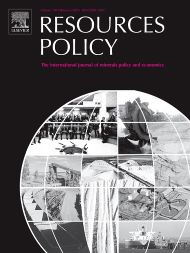Aboriginal employment outcomes at Argyle Diamond Mine: What constitutes success, and for whom?
Indigenous participation in the Australian mining workforce has rapidly increased over the last 15 years, yet little is known about what outcomes have been achieved for those employed. Using a case study of Rio Tinto's Argyle Diamond Mine in the Kimberley region of Western Australia, this paper begins to explore the extent to which Aboriginal people succeeded in achieving, as articulated in the Indigenous land use agreement, “good careers at the same time as following their culture” (MPA, 2004:101). To consider this issue, we draw on elements of the Yap and Yu (2016, 2016a) Yawuru wellbeing indicators, on the basis that the structures and indicators of wellbeing followed by the Traditional Owners associated with the agreement have not been recorded in the wellbeing scholarship. With the mine closed in late 2020 after almost 40 years, the question of what outcomes Aboriginal employees have achieved is a critical one to consider. Although disaggregating the effects of mining employment from other aspects of the benefit stream within the agreement is not straightforward, a focus on the experiences of those Aboriginal employees at Argyle provides a corrective to the lack of empirical research over the last decade.
Language: English
Publisher: Resources Policy
Region: Australia
Type: Research Paper
CITATION
Parmenter, J., Dowell, K., Holcombe, S., & Alexander, R. (2023). Aboriginal employment outcomes at Argyle Diamond Mine: What constitutes success, and for whom?. Resources Policy, 87, 104327.
https://doi.org/10.1016/j.resourpol.2023.104327

